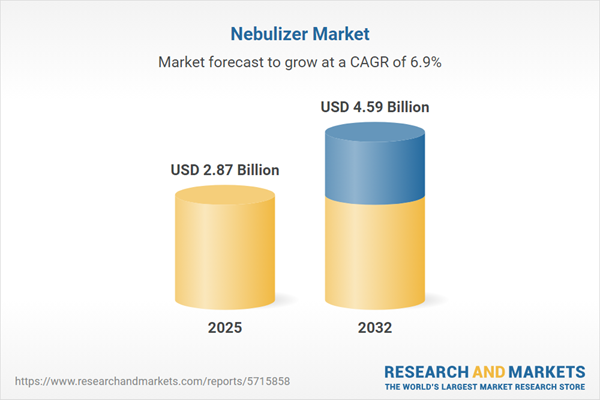Speak directly to the analyst to clarify any post sales queries you may have.
Senior leaders operating in the nebulizer market must navigate a rapidly changing environment shaped by evolving technologies and healthcare delivery models. This report synthesizes the most relevant market intelligence, enabling executives to anticipate shifts, mitigate risks, and strengthen decision-making in this competitive space.
Nebulizer Market Snapshot: Growth, Trends, and Dynamics
The global nebulizer market is valued at USD 2.68 billion and is projected to reach USD 2.87 billion by 2025, with a compound annual growth rate (CAGR) of 6.92%. Industry expansion is driven by rising awareness of respiratory health, increasing reliance on home-based therapies, and integration with advanced digital health technologies. Major corporations and new entrants alike are intensifying competitive efforts through partnerships and operational efficiencies. The landscape requires organizations to remain responsive, strategically agile, and able to leverage opportunities arising from new delivery platforms, while meeting heightened demands from both consumers and regulators.
Scope & Segmentation: Comprehensive Nebulizer Market Overview
This report provides in-depth insights for executives to formulate robust entry, investment, and portfolio strategies in the nebulizer market. Detailed segmentation enables better alignment with changing operational requirements and regulatory expectations across regions and end-user needs.
- Product Types: Jet nebulizers deliver reliable and precise medication dosing; mesh nebulizers emphasize portability and dosing accuracy; ultrasonic models offer compact, lightweight operations suitable for clinical and home use.
- Operation Modes: Breath-actuated units support both intermittent and continuous therapies, delivering flexibility for various healthcare workflows.
- Distribution Channels: Hospitals, retail pharmacies, specialty wholesalers, e-commerce, and third-party online platforms expand market reach to institutional and residential customers.
- End Users: Clinics, specialist centers, integrated hospital networks, and homecare affiliates rely on diversified device portfolios to address a broad spectrum of respiratory conditions.
- Applications: Devices facilitate treatment for asthma, chronic conditions like COPD and bronchiectasis, and rare disorders such as cystic fibrosis, supporting continual product innovation and customization.
- Regions Assessed: The report evaluates North America, Latin America, Europe, Middle East, Africa, and Asia-Pacific, highlighting key progress in markets such as the United States, Brazil, United Kingdom, UAE, South Africa, and China.
- Company Coverage: Leading participants include Koninklijke Philips N.V., Omron Corporation, PARI GmbH, Drive DeVilbiss Healthcare, Jiangsu Yuyue Medical Equipment & Supply, Vyaire Medical, Trudell Medical International, Caire Inc., Becton Dickinson and Company, and Aerogen Ltd., reflecting extensive innovation and supply chain strength across the global sector.
Nebulizer Market: Key Takeaways for Senior Executives
- Digital health integration is making scalable remote management possible, improving care coordination across expanding provider networks.
- Ongoing advances in mesh technology offer increased patient mobility and enable new models of decentralized care.
- Device manufacturers and pharmaceutical companies are increasingly collaborating to enhance regulatory responsiveness and address dynamic reimbursement frameworks.
- Focus on sustainable sourcing and responsible manufacturing is becoming essential to meeting evolving compliance and risk requirements.
- Widespread use of digital training resources is strengthening care team proficiency and supporting value chain consistency.
Tariff Impact: Navigating Cost and Supply Chain Complexities
Changes to U.S. tariff regimes have led producers and suppliers to diversify their sourcing routes and invest in localized assembly. The adoption of real-time analytics across supply chains improves transparency and enables rapid detection and mitigation of disruptions. These strategies help maintain cost efficiency and resilience in the face of changing market conditions.
Methodology & Data Sources
This report combines quantitative market data from industry-leading journals, reliable databases, and regulatory authority updates. Qualitative insights from procurement specialists and sector experts ensure that the analysis reflects current executive priorities and operational realities within the nebulizer sector.
Why This Report Matters for Executives
- Provides actionable guidance to streamline operations, drive digital transformation, and leverage new opportunities in the medical device sector.
- Facilitates reliable benchmarking, targeted risk mitigation, and high-value investment decision-making in evolving market conditions.
- Enables strategy development grounded in thorough segmentation and market analysis, supporting resilience and strategic opportunity capture.
Conclusion
This report equips senior leaders with nuanced market context, allowing for informed strategic alignment and effective navigation of market developments as the nebulizer sector continues to evolve.
Additional Product Information:
- Purchase of this report includes 1 year online access with quarterly updates.
- This report can be updated on request. Please contact our Customer Experience team using the Ask a Question widget on our website.
Table of Contents
3. Executive Summary
4. Market Overview
7. Cumulative Impact of Artificial Intelligence 2025
Companies Mentioned
The companies profiled in this Nebulizer market report include:- Koninklijke Philips N.V.
- Omron Corporation
- PARI GmbH
- Drive DeVilbiss Healthcare, Inc.
- Jiangsu Yuyue Medical Equipment & Supply Co., Ltd.
- Vyaire Medical, Inc.
- Trudell Medical International Ltd.
- Caire Inc.
- Becton Dickinson and Company
- Aerogen Ltd.
Table Information
| Report Attribute | Details |
|---|---|
| No. of Pages | 192 |
| Published | October 2025 |
| Forecast Period | 2025 - 2032 |
| Estimated Market Value ( USD | $ 2.87 Billion |
| Forecasted Market Value ( USD | $ 4.59 Billion |
| Compound Annual Growth Rate | 6.9% |
| Regions Covered | Global |
| No. of Companies Mentioned | 11 |









